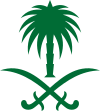Royal Saudi Air Defense Forces
| Royal Saudi Air Defense | |
|---|---|
| الدِفَّاع الجوّي المَلكِيَّ السُّعُودِيَّ | |
 Emblem of the RSADF | |
| Founded | 1930[a] |
| Country | |
| Type | Air defense |
| Role | Aerial warfare |
| Size | 16,000[2] |
| Part of | Royal Armed Forces |
| Headquarters | Riyadh (central HQ)[3] |
| Colors | |
| Engagements | Action of June 5, 1984 Gulf War Saudi Arabian-led intervention in Yemen |
| Website | www.rsadf.gov.sa |
| Commanders | |
| Current commander | Lt. General Mazyad al-Amro |
| Insignia | |
| Flag |  |
The Saudi Arabian Air Defense Forces or officially Royal Saudi Air Defense Forces (RSADF) (Arabic: قُوَّات الدِفَاع الجوّي المَلكِيَّ السُّعُودِي) is the aerial defense service branch of the Saudi Arabian Armed Forces (SAAF). It is fourth of the five service branches of the MOD.[1][3] It has its HQ in Riyadh,[b] where there is also an elaborate underground command facility that co-ordinates the kingdom's advanced "Peace Shield" radar and air defense system, with an estimated 40,000 active duty military personnel in 2015.[4][5] Along with the Royal Saudi Air Force (RSAF), it has the responsibility for securing the skies of Saudi Arabia.[6]
Overview
[edit]Towards the end of the 1970s, a paradigm shift occurred with the SAAF with the making of the RSAD Corps as a separate and equivalent service, equal to the Army, Navy, and Air Forces. It is no longer subordinate to the RSLF. The impetus behind this shift is the ever-changing threat. The concern by the Kingdom of proliferation of weapons of mass destruction and their mechanism of delivery, resulted in the early understanding by the MoD of the requirement to transform, and thus the creation of the RSADF.[7]
Between 2017 and 2020, the RSAF claimed the interception of 311 cruise missiles and 343 suicide drones but failed to stop some of the attacks against the strategic Saudi sites of the Houthi movement and Iran.[8]
Peace Shield
[edit]- Remote-controlled air/ground radio communications sites.
- 17 Lockheed Martin AN/FPS-117 long-range phased array, 3-dimensional air search radar.
- 6 Northrop Grumman AN/TPS-43 portable 3-dimensional tactical air search radar.
- Raytheon Improved HAWK air defense missile system.
- Raytheon MIM-104 Patriot air defense missile system
- Oerlikon Contraves Skyguard 35mm Twin Cannon Short Range air defense system
- Lockheed Martin THAAD anti-ballistic missile defense system.
- LIG Nex1 KM-SAM[9]
Source:[10]
Past Inventory
[edit]| Weapon | Origin | 1990 | 2000 | 2005 | 2006 | |
|---|---|---|---|---|---|---|
| Anti-Aircraft Artillery | ||||||
| M163 VADS | United States | 92 | 92 | 92 | 92 | |
| AMX-30SA | France | 50 | 50 | 50 | 50 | |
| Oerlikon GDF | Switzerland | 128 | 128 | 128 | 128 | |
| Bofors 40mm L/70 | Sweden | 150 | 150 | 150 | 70 | |
| Surface-to-Air Missiles | ||||||
| Shahine | France | 141 | 141 | 141 | 141 | |
| I-HAWK | United States | 128 | 128 | 128 | 128 | |
| Crotale | France | 0 | 40 | 40 | 40 | |
| FIM-92A Stinger/Avenger | United States | 0 | 0 | 400 | 400 | |
| FIM-43 Redeye | United States | 0 | 0 | 500 | 500 | |
| Mistral | France | 0 | 0 | 500 | 500 | |
| PAC-2 Patriot | United States | 0 | 0 | 0 | 640 | |
See also
[edit]Notes
[edit]- ^ 1930–1955 (as a part of the Artillery Arm of the Saudi Army)[1] 1956–1963 (as a part of the formation of the Artillery Corps)
1963–1983 (an independent corps of the R.S. Land Forces) 1984– present (fourth armed service branches of the MOD). - ^ Air Defense Ministry Building designed by Arthur Erickson Architects with Bing Thom
References
[edit]- ^ a b "Royal Saudi Land Forces History". GlobalSecurity.org. Retrieved 1 February 2017.
- ^ IISS (2021). The Military Balance 2021. Routledge. p. 365. ISBN 978-1-032-01227-8.
- ^ a b c Al Saud, K. Royal Saudi Air Defense Forces, al-Moqatel (in Arabic) online.
- ^ "Saudi Arabia spends 25% of its budget on its military — here's what it has for the money". Business Insider. Archived from the original on 2 January 2016. Retrieved 21 March 2016.
- ^ Anthony Cordesman (2009). Saudi Arabia: National Security in a Troubled Region. p. 387.
{{cite book}}:|work=ignored (help) - ^ "Royal Saudi Air Defence Force - Responsibilities".
- ^ "Royal Saudi Air Defense Forces". globalsecurity.org. Retrieved 16 May 2019.
- ^ "Attaque suicide en Arabie-Saoudite: Nouvel échec du systéme Patriot". 19 March 2021. Retrieved 9 December 2021.
- ^ "Saudi Arabia signs $3.2B deal for South Korean air defense systems". 7 February 2024.
- ^ Janes-Military-Communications, 5 July 2005, Peace Shield (Saudi Arabia), Systems Archived 28 September 2010 at the Wayback Machine Retrieved 2012-01-23
- ^ Cordesman, A. H., Al-Rodhan, K. R. (2006). Gulf Military Forces in an Era of Asymmetric Wars. United Kingdom: Praeger Security International. P. 208
External links
[edit]- R.S. Air Defense Archived 24 February 2018 at the Wayback Machine official website
- Moqatel (Warrior Desert)

